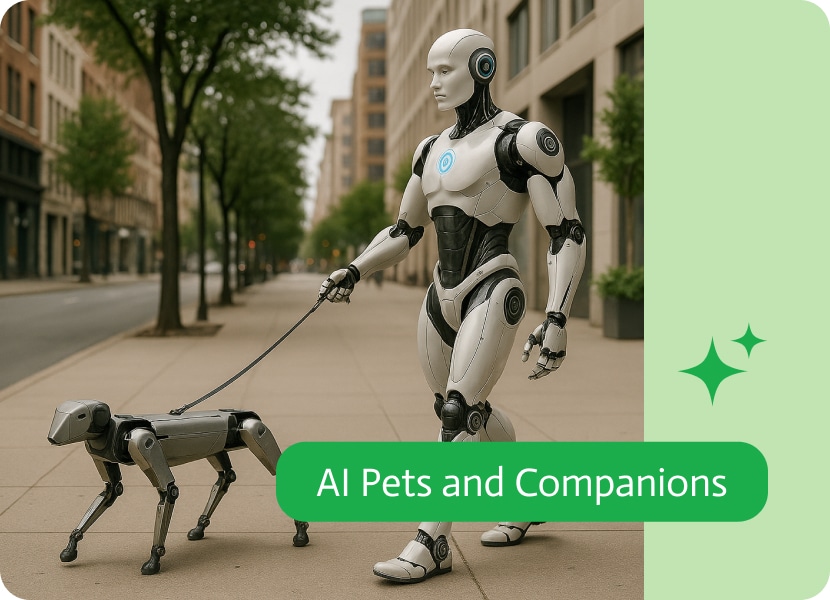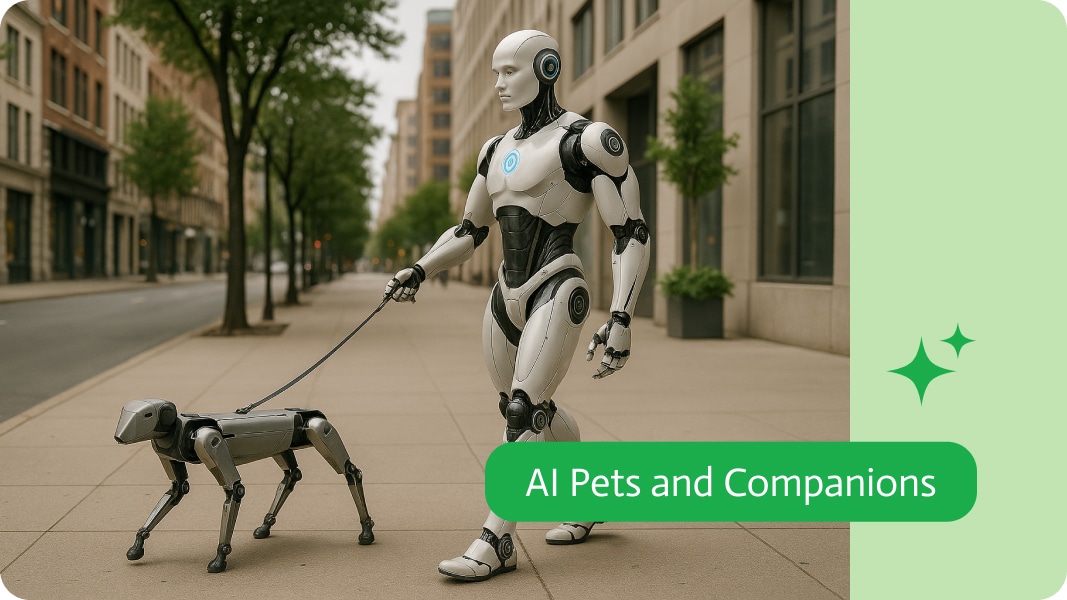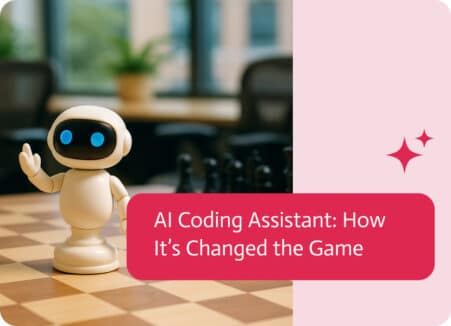

The Uncanny Rise of AI Pets & Companions
AI pets and companions are essentially artificial intelligence systems designed to provide companionship, emotional support, and interaction, much like real pets or human friends. They come in various forms, from digital applications to physical robots, but they all have their benefits.
AI Pets and Companions: A Quick Look
Digital Pets:
Think Tamagotchis but way fancier. These are programs you can get on your phone or computer. They act like pets, react when you play with them, and can even grow up depending on how much attention you give them.
Robotic Pets:
These are actual robots made to look and act like real animals, like dogs or cats. They use robot stuff, AI, and sensors to move around and play with people. Sony’s AIBO robot dog is one example. There are also robot cats that help older folks.
AI Companions (Chatbots/Avatars):
Mostly, these are about talking. They’re apps or avatars that chat with you like a person, give advice, lend an ear, and can even act like friends or partners. They’re powered by fancy language tech and AI that lets them have pretty real conversations.
What Are AI Pets?
AI pets are essentially robotic or virtual animals designed to act like real pets, but without the litter box, vet bills, or chewed-up shoes. They interact using sensors, cameras, microphones, and some impressively clever AI algorithms that help them respond to voice, touch, and even your mood.
Examples of AI Pets
- Sony’s Aibo: This robotic pup can recognize faces, respond to your voice, learn new tricks, and even show emotions through tail wags and ear twitches. It evolves its personality over time based on how you treat it.
- Tamagotchi-style apps with AI: Think next-gen virtual pets that live in your smartphone or on your AR glasses. They can play games, remind you to feed them, and react emotionally if you ignore them for too long.
- Paro the Seal: This AI therapy animal is widely used in elder care. It’s cuddly, soft, and responds to petting by moving its head, blinking, and making happy seal noises. Yes, really.
What They Can Do
AI pets aren’t just about looking cute. They’re capable of:
- Learning from interactions (e.g., understanding when you like to play)
- Recognizing people using computer vision
- Simulating emotion through movement, sound, and facial expressions
- Offering companionship, especially for children, seniors, or those who can’t keep real pets
And while they can’t wag a real tail or sit on your lap with warmth, they’re often surprisingly comforting, especially to those experiencing loneliness or anxiety.
What Are AI Companions?
Imagine a buddy who never gets tired of listening and somehow always knows just what to say. That pretty much sums up an AI companion.
People call them digital friends, therapy bots, or even soulmate software. The machines don’t bark like a pet, and they sure don’t purr like a cat; they try to fill the holes a lonely person might feel in any average day or quiet night.
Examples of AI Companions
- Replika: Ever wonder if a chatbot could keep a secret? Replika does. Users say it remembers birthdays, bad days, and random quirks; it’s like having a diary that talks back without any judgment at all.
- Anima AI: Fancy a digital sparring partner who doesn’t mind being wrong half the time? Anima lets you shape its tone, so it can crack jokes, flirtatiously debate, and then switch gears to help you tackle an unexpected midnight crisis.
- Gatebox: Picture a petite holographic partner sitting in your living room, calling you by name, and turning off the lights with a flick of her virtual wrist. She’s big in Japan and the closest thing yet to a wife made of pixels and good coding.
What They Can Do
A virtual pet can hold an upbeat, flowing chat that feels neighborly instead of robotic. You don’t have to repeat yourself; each talk builds on the last.
The companion quietly learns what makes you smile, what annoys you, and how you sound when you’re worn out. When stress hits, the app can suggest a deep breath or crack a quick joke that somehow lands.
Think of it as having a pocket cheerleader who celebrates your wins, big or tiny, and nudges you when motivation dips. Give it a few weeks, and the replies start to click in a way that feels almost spooky; the gizmo keeps evolving as you tap or talk.
How Do They Work?
Counter to movie magic, the gadget runs on some very real tech under the hood.
- Natural Language Processing, or NLP for short, helps it hear you, well, decode your typeface or your voice, and spit back something that fits.
- Machine-learning algorithms sit in the background, crunching the chats so the next answer feels less like a textbook line and more like an inside joke.
- For plastic pets, a palette of sensors, including light sensors, cameras, and even a few mushy touchpads that turn the world into a stage set the robot can read.
- Generative AI stitches fresh content on the fly, whether a silly pun, a mini story about a runaway sock, or a wiggly GIF that gets repeated only once.
Emotional Recognition
Most modern AI companions can do more than just talk in a friendly voice. The software might pick up the pitch of your speech, scan your text for clues, or even use a camera to spot the tiny smiles and frowns on your face, then guess how you’re feeling. That guess shapes how the bot replies.
Companionship and Emotional Support
For someone who spends long hours alone, a digital sidekick can feel surprisingly real. The program rarely judges and almost never tires of listening, so it becomes an instant friend. Seniors, shut-ins, and folks too busy for a breathing pet often lean on this very comfort.
Stress Reduction
Tapping and swiping at an animated dog or cat on a tablet can lower anxiety the same way stroking a fur coat does. The difference? No fur getting stuck to your sweater.
Low Maintenance
Push buttons instead of opening cans. This animal needs no food bowl, dollop of shampoo, or trip to the vet, which suits students, allergy sufferers, or anyone elbow-deep in a hectic schedule.
Accessibility
Renters living in no-pet zones or patients with weak immune systems still want connection, and a wireless companion slips right past those barriers.
Entertainment and Engagement
Many of these gadgets come loaded with games, bedtime stories, trivia quizzes, and even science experiments, so boredom runs for cover. Parents like the learning angle, and kids just think the digital critters are a blast.
Therapeutic Applications
Believe it or not, little robotic dogs sometimes find their way into nursing homes. Therapists use them with dementia patients, and the furry machines can spark smiles when nothing else will. People who talk to the bots often open up more than they do to real humans.
But They-Not-All-Cuddles-and-Code
Flat circuits and soft fur sound cozy, yet these gadgets come with caution signs. They aren’t just toys; they’ve got strings attached.
Emotional Dependence
Some users admit they suddenly care too much for code that glows instead of fur. Falling for a voice that only gives hugs when you ask for one seems harmless, until it doesn’t.
Privacy Concerns
Every laugh, tear, and boring routine gets stored somewhere, usually in the cloud. That helpful memory can become a creepy diary if the company plays fast and loose with your files.
Unrealistic Expectations
A blinking eye that never judges can spoil our view of real friends, who forget stuff and make mistakes. When a bot seems perfect, suddenly humans feel a little busted.
A Glimpse Into the Future
Picture waking up tomorrow, checking the news, and finding that a pocket-sized AI buddy is now as common as that cracked smartphone screen you keep meaning to fix. What once felt like flashy science fiction has slowly squirmed its way into breakfast, the workday, and even the late-night scroll through memes. Nobody is gasping anymore, because the sparkly wow factor has been replaced by quiet reliability.
Here’s where the path may lead:
Group Conversations with Real Presence
Most of us think of an AI friend as someone who slides into DMs and shoots back one-on-one replies. What if, instead, you invited that same helper to a virtual dinner table, and it kept up with the jokes, settled a trivia debate, and even smoothed over a family flare-up without taking sides? It might feel a bit like having an extra, super-tactful cousin sitting right there.
Fully Embodied in Humanoid Robots and AR Interfaces
Now imagine that same buddy, but barefoot and standing in your kitchen, micro-expressions bouncing across its face the way yours do when you really nail a recipe. Pair that little miracle with lightweight AR glasses, and your helper can zip alongside you on a walk while flipping through your to-do list and pointing out cool shortcuts. The voice in your ear suddenly has ticker-tape legs, maybe even waving goodbye as you head out the door.
Personalized Wellness Coaches
Swipe past that generic self-help app for a minute. Picture a pocket-size coach that checks your mood, nudges you to breathe when your voice spikes, and even reminds you to stretch before the crick in your neck gets serious. By watching your heart rate, scanning your text tone, and maybe sneaking a peek at your calendar, the thing personalizes its advice the way a good therapist would, or like that friend who always seems to know when you need a snack.
A New Tool Against Global Loneliness
Loneliness is sneaking into more lives than most of us want to admit, and that’s where these AI buddies start to shine. An older person living by themself might chat with a robotic pet that purrs at just the right moment, paces medication reminders, and rings a child if something looks off. Teens in the middle of nowhere may find a steady ear in the same gadget, someone who never judges but always listens and says, Hey, you’ve got this.
But Still, a Matter of Balance
The screen charm can flip over into too much if we aren’t careful. No piece of code can give you the warm rush of a real hug or the clumsy comfort your brother offers after a breakup, so relationships with machines should sit next to, not on top of, human ones. Designers have to draw clear lines, and we each need the smarts to say, Okay, great tool, but I still need dinner with friends tonight. The goal is to fill the empty spots without forgetting what makes us, well, us.
Vibe Code A Pet or Companion With Noca
Noca.ai isn’t specifically designed to create AI pets, but that doesn’t mean you can’t think out of the box and make use of its vibe coding to make your very own AI buddy. Here’s how:
- Describe what you want your AI pet’s personality to be like.
- Explain how you want to interact with your digital friend.
- Describe the responses and actions you want it to make.
- Sketch or describe how you want it to look.
Main Perks:
- Anyone can do it, even without coding skills.
- Quickly make and test out ideas.
- Get feedback and see previews right away.
- Works with tools you already use.
Noca helps fix the developer shortage and lets product managers, designers, marketers, and new business owners create software easily.
So, while Noca’s vibe coding can help create AI pets or friends, it’s really a platform for making any kind of software app through simple, conversational ways instead of old-school coding.
Final Thoughts
Not long ago, having a robot pet felt miles away from the pages of a comic book. Now you can actually hug a furry bot seal or swap jokes with a cartoon-like boyfriend that lives in your phone. Weirdly enough, many people already say they’re starting to really care.
These gizmos don’t plan a hostile takeover of your evenings. They just slide into the blank stretches between calls, nudge you to drink some water, crack a dumb joke, and sit still while you vent about work for the hundredth time.
A computer chip can never grow a heartbeat, yet the clever lines of code pumped in behind the curtain sure make you check your pulse anyway. Pretty soon, the real question will be less about whether what you’re staring at is real and more about figuring out where it fits on your schedule.


